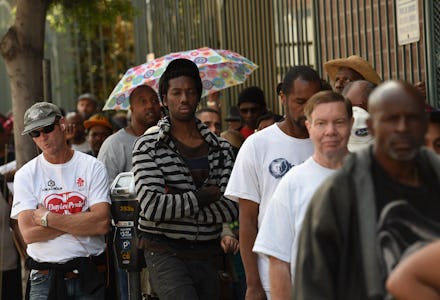What the Conversation About Income Inequality Keeps Getting Wrong About Black People

It's easy to think that the economy's on the upswing. Unemployment is down, and jobs are plentiful. In August the black unemployment rate fell below 10%, which, while still twice the rate of white unemployment, seemed a vast improvement over previous years, when joblessness in black communities hit record highs.
But those steady improvements mask a daunting truth. In a series of fact sheets released last week, the Center for American Progress demonstrates just how important people of color will be to the United States' political and economic future.
The figures, from a project CAP calls Progress 2050, paint a broad picture of demographic change, which has been described across the political spectrum as the "browning of America." That change, from a centuries-long white majority to a new, politically powerful majority of color, is widely expected to take place by the year 2050, but Census figures show it's already happening in states like California, New Mexico, Texas and Hawaii as well as the District of Columbia.
Numbers don't necessarily equal power. By 2018, CAP estimates, people of color will have six times the buying power that they did in 1990 — more than $3.6 trillion (likely due to the growth of this population). Here's how that breaks down: Asian-Americans are projected to make up 6.3% of the U.S. consumer market, Latinos are expected to reach 10.6% and African-Americans are expected to make up 8.8%. Those numbers are great for the consumer market, but not necessarily so for people of color, because while people of color can indeed buy more, the reality remains that they're worth less.
Specifically, the racial wealth gap — the widening distance between white and black wealth — is larger than it's ever been. And without explicit changes in policy, it will only grow bigger.
That gap has always existed, but it's only grown worse in recent years. In 2004, white households had 11 times the estimated median wealth of black households; by 2009, that rate had grown to 19 times. The reasons for the racial wealth gap are varied. The recession slammed everyone, but was particularly brutal for people of color. Unemployment rates for black Americans were so bad, in fact, that some researchers said that black people were going through a "silent depression" that equaled or exceeded the Great Depression of 1929.
Since so many people of color built wealth by purchasing homes, they were uniquely impacted by the foreclosure crisis that fueled the economic meltdown. In 2007, home equity made up more than 38% of black family net worth, and nearly 40% for Latinos, but only 23% for white families, according to a 2012 report from United for a Fair Economy, a left-leaning policy group. Yet even before the Great Recession, public policy put communities of color in a hole they're still trying to climb out of.
"Things are getting better but there's still work to be done," Tracey Ross, associate director of the CAP's Poverty to Prosperity program, told Mic. "There's an increased purchasing power, but in the longer term we need to ensure there's more wealth accumulation."
Where do we go from here? The racial wealth gap is especially relevant to millennials. Think about it: Where will you be in 20 years? According to the American Dream, you'll have a home and maybe some kids, all while building toward some type of retirement. But that dream is looking like less of a reality for millennials, who are mired in student loan debt or shut out of the economy altogether — forget the thought of buying a home.
As 2016 presidential contenders speak candidly about income inequality, those like Bernie Sanders and Hillary Clinton cautiously approach the issue of racial inequality that underpins many of those disparities. Aside from the policy argument, there's a moral element to closing the racial wealth divide, too.
"Our commitment to closing this divide should not depend on whether people of color make up 5% or 75% of the population," United for a Fair Economy wrote in a 2012 report. "And, as people of color become the new majority, the persistent racial disparities of the past threaten to jeopardize the social fabric of our nation and our economic stability."